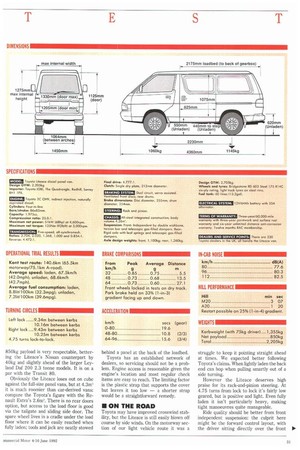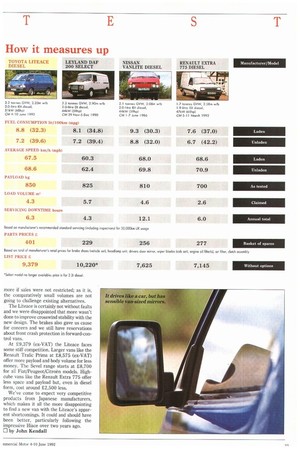TOYOTA LITEACE
Page 32

Page 33

Page 34

Page 35

If you've noticed an error in this article please click here to report it so we can fix it.
Anew vehicle usually gives manufacturers the excuse to indulge in a fanfare of advertising, press and dealer launches. As a rough guide, the louder and longer the fanfare, the more important the vehicle is to the manufacturer — importance being measured in sales potential.
On this Richter scale, Toyota's launch of the latest Liteace registered no more than a mild tremor. With projected UK annual sales of 1,200-1,300, Japan's largest motor manufacturer has more profitable model ranges to concentrate on. Its CV quota for 1992 will be around 6,500 units, with the biggest chunk allocated to the Hilux 4x4.
Compare that with the 60,000 sales predicted by market leader Ford, and Toyota could be forgiven for not bothering at all.
As reported (CM 7-13 May), the Liteace has been treated to a new bodyshell offering a bigger volume and payload. Toyota has also remedied the lack of a diesel option with a two-litre lump from the Carina car range. Petrol models retain their 1,486cc engine and Toyota expects sales to split 55% diesel to 45% petrol, as the appeal of
the Liteace is mainly for urban deliveries. It's the all-new diesel model that we test this week.
• PRODUCT PROFILE Toyota has made much of the Liteace's improved safety features. The wheelbase has been increased by 130mm; the track is wider by 30mm at the front and 40mm at the rear. This, combined with the new body shape, is said to enhance crosswind stability by 9%.
Mind you the new body won't win any beauty contests: to some eyes it's just plain ugly, thanks mostly to the black plastic front grille and bumper which looks like something of an afterthought, The rear is much tidier.
With the increased wheelbase comes a 365mm increase in overall length. It's also 35mm wider and 70mm lower, boosting volume by 21%, to 4.3m3. Payload is up to 850kg in diesel guise with 75kg driver (the lighter petrol model offers another 20kg). Four tie-down eyes are provided but they are placed fore and aft of the rear axle, leav
ing loads further forward to slide around.
The forward control layout can leave driver and passenger vulnerable in a frontal impact but Toyota has taken serious steps to improve crash protection. Both front doors and the side loading door are fitted with side impact beams; the Y-shaped front chassis members have been reinforced and braced with cross-members to improve front impact protection. Toyota also claims greater rigidity for the new body, with reduced noise levels.
The two-litre diesel produces 51kW (68hp) at 4,600rpm with 125Nm (921bft) of torque at 3,000rpm. Power is marginally less than the 1,500cc petrol engine, but the diesel produces more torque. A conventional drivetrain transmits the drive to the rear wheels through a five-speed all synchromesh gearbox.
• PRODUCTIVITY The diesel engine provides the Liteace with strong performance, but not at the expense of fuel consumption. Its laden consumption figure of 8.81it/100km (32.3mpg) beats the 9.21it/100km (30.3mpg) we recorded for the Nissan Vanette diesel, but could not match the Leyland Daf 200 Select's 8.1lit/100km (34.8mpg). The unladen figure was an impressive 7.21it/100km (39.6)mpg.
The Liteace is quite a lively performer which won't embarrass its driver in stop/ start town traffic, even with a full load. The
850 kg payload is very respectable, bettering the Liteace's Nissan counterpart by 40kg and slightly ahead of the larger Leyland Daf 200 2.3 tonne models. It is on a par with the Transit 80.
Obviously the Liteace loses out on cube against the full-size panel vans, but at 4.3in' it is much roomier than car-derived vans: compare the Toyota's figure with the Renault Extra's 2.6rn. There is no rear doors option, but access to the load floor is good via the tailgate and sliding side door. The spare wheel lives in a cradle under the load floor where it can be easily reached when fully laden; tools and jack are neatly stowed behind a panel at the back of the loadbed.
Toyota has an established network of dealers, so servicing should not be a problem. Engine access is reasonable given the engine's location and most regular check items are easy to reach. The limiting factor is the plastic strap that supports the cover but leaves it too low — a shorter strap would be a straightforward remedy.
• ON THE ROAD
Toyota may have improved crosswind stability, but the Liteace is still easily blown off course by side winds. On the motorway section of our light vehicle route it was a struggle to keep it pointing straight ahead at times. We expected better following Toyota's claims. When lightly laden the back end can hop when pulling smartly out of a side turning.
However the Liteace deserves high praise for its rack-and-pinion steering. At 4.75 turns from lock to lock it's fairly low geared, but is positive and light. Even fully laden it isn't particularly heavy, making tight manoeuvres quite manageable.
Ride quality should be better from front independent suspension: the culprit here might be the forward control layout, with the driver sitting directly over the front axle. This tends to accentuate suspension movement for the driver and passenger.
The engine location weighs against peaceful progress and in-cab noise levels are high, as our noise readings show. It's not the only noisy panel van on the market, but it's time that all manufacturers addressed this particular problem.
The handbrake performed well on the Chobham test hills, holding the Liteace fac
ing up and down on the 33% (1-in-3) slope. The service brakes felt fine in ordinary use but we were in for a surprise in our panic stop testing. Instead of the progressive stops we were expecting, the Liteace needed a firm hand on the wheel to keep it in a straight line.
We experienced similar behaviour in all three tests; from 32 km/h, 48km/h and 64Iun/h. The tyre marks on the test track suggested that the nearside front wheel had locked and released, then the offside front wheel locked, causing it to swerve. We hope that this was an isolated case.
• CAB COMFORT
Accommodation is not a strong point in any Japanese panel van. There was adequate legroom but the narrow cab left us short of elbow room and storage space. Oddments can be stowed in the moulded tray around the gearlever and in the large, shallow tray between the seats, but while the glovebox is a reasonable size it has no lock, and the doors lack sufficient space for pockets.
Climbing into the cab is easier than some other forward control vans, with no risk of wiping muck from the wheel arch over clothes in the process. Even so, access is still awkward when compared with other van layouts. Although the driving position is generally good, the seats could do with a bit more padding to offer more support.
The interior bears an obvious family resemblance to the Hiace but that's no bad thing. The mouldings have a good quality appearance despite the dominant grey and the instruments are large and clear.
Most functions are controlled by the column stalks but they are a strong reminder that the time for standardisation is long overdue. Indicators and wipers are on opposite sides from European designs and we soon tired of wiping the screen instead of operating the indicators. Manufacturers managed to standardise pedal layout on left and right-hand drive vehicles years ago, so it should be possible to sort out a few column stalks.
As the Liteace is a panel van, it gets sensible panel van door mirrors which give good visibility to both sides. The rear wash/wipe and heated window come as standard and help to improve all-round visibility.
Common to most Japanese vans is the excellent heating and ventilation system. Its only drawback is the heater controlled fascia vents, so no warm feet and cool head. Otherwise it offers a good flow of air, a fourspeed fan and recirculation facility.
• SUMMARY
Between them, the Toyota Liteace and the Nissan Vanette have created a market niche of their own. The combination of good body volume and panel van payload potential must be appealing to many buyers, particularly for urban use, where family car dimensions and manoeuvrability give it an edge over other van designs.
A car-derived van can't match its payload or body volume, while a full size panel van might feel too big for someone more used to driving a small car.
No doubt Nissan and Toyota could sell more if sales were not restricted; as it is, the comparatively small volumes are not going to challenge existing alternatives.
The Liteace is certainly not without faults and we were disappointed that more wasn't done to improve crosswind stability with the new design. The brakes also gave us cause for concern and we still have reservations about front crash protection in forward-control vans.
At £9,379 (ex-VAT) the Liteace faces some stiff competition. Larger vans like the Renault Trafic Prima at £8,575 (ex-VAT) offer more payload and body volume for less money. The Sevel range starts at £8,700 for all Fiat/Peugeot/Citroen models. Highcube vans like the Renault Extra 775 offer less space and payload but, even in diesel form, cost around £2,500 less.
We've come to expect very competitive products from Japanese manufacturers, which makes it all the more disappointing to find a new van with the Liteace's apparent shortcomings. It could and should have been better, particularly following the impressive Hiace over two years ago.
fl by John Kendall














































































































